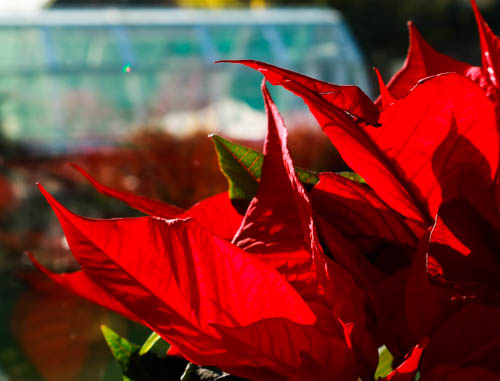
Now’s the time of year to buy Amaryllis, (Hippeastrum) ready for flowering for the festive season. Start them into growth in the greenhouse then bring them indoors to flower. Water sparingly at first; trickling a little tepid water around the bulb, and increasing the amount as growth appears. Once they are actively growing, keep them constantly moist but not waterlogged and take care not to get the growth tip wet. Stake the flowering stems carefully to prevent them from falling over. They like temperatures between 60-65degF, so a warm spot ideal. Once indoors keep room temperatures cool to prolong the flowering period – this applies to ‘Indian Azalea’s’, ‘Poinsettia’ and ‘Christmas cactus’, too. (Don’t forget to remove any of your houseplants from the windowsill during the night, as they are easily damaged by low temperatures).
Keep an eye out for over-wintering aphids, whitefly, red spider mite and other pests, including errant slugs hiding under pots and control them immediately. Continue successional sowing of salad leaves. Warming the compost in a heated propagator beforehand will help germination. Remove any fallen leaves and debris and add them to the compost heap.
Wash your pots and seed trays in soapy water, drying and stacking in size order so they are clean and ready for early next year. Wash down benches and propagators, to control diseases. A little environmentally friendly disinfectant in the water will help with this. Bubble wrap the greenhouse or part of it, if you haven’t done so already.
If you need a break from the festivities, Christmas or Boxing Day are the traditional dates for sowing onion seeds. Space them evenly over the surface of moist seed compost, and lightly cover with fine grade vermiculite. Put the tray in a heated propagator at 20C (70F) and they will germinate in 10-14 days, artificial light will help growth once they have germinated, too.
Plant garlic in pots or modules of multipurpose compost in colder areas particularly on heavy, wet soils, where growing on ridges is not an option or where there is a short growing season. It needs a long growing season and around 6 to 8 weeks around 0-10C for optimum production, so a cold greenhouse is ideal. Water as it starts into growth and transplant when the soil dries and warms and growing conditions improve in spring.
Force ‘witloof’ chicory by lifting roots, potting them up into deep trays or three per 25cm pot of multipurpose compost, then covered with an upturned pot to block out the light. Keep the compost moist to encourage growth.
Open greenhouse vents for as long as possible on mild sunny days over winter, shutting them before temperatures drop early in the afternoon. A combination of high temperatures and low light makes leaves and stems soft, spindly and prone to grey mould which spreads rapidly in cool, damp conditions. Though good air circulation is vital, avoid chilling draughts, don’t leave the door open and always err on the side of caution!
Happy Christmas. Matt


